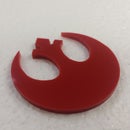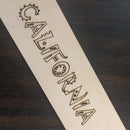Introduction: PCB Isolation Track Milling With MyDIYCNC Desktop CNC Machine
Hey there,
Tory @ MyDIYCNC here again to show you another cool project that is very easy on your Desktop CNC machine. We are going to be milling out isolation tracks into blank PCB material to male rapid-prototyping printed circuit boards. With all the right tools, its fun, cool, useful, and easy! So lets go ahead and jump in and get started!
Milling PCB's is the quickest, cleanest (no chemicals) and easiest way to get from on-computer circuit design to prototype board in your hands, ready to be soldered up to test. We do this routinely in-house and use EagleCAD to design our circuit boards and it’s pcb-gcode plugin to export our newly-designed PCB to G-Code to be processed in FabCAM on our desktop CNC machine.
This can be done with FabCAM on PC, Linux or Mac. Also FabCam comes with free sample PCB G-code files.
Step 1: Gather Your Supplies!
First off, lets get all the supplies ready. This is what we need:
Your CNC machine, I am using my MyDIYCNC Desktop CNC machine.
One V shape bit, I am using a 20 degree bit, I like this one for the thin tracks it produces.
One end mill to mill out a level bed, I am using a 1/8" router bit.
A sacrificial piece of board for a milling bed, I am using a piece of PVC foam board.
An adhesive tape or some sort of way to mount your milling bed to your CNC machine and your PCB to your milling bed. Carpet tape is what we use, works great and can be found at most hardware stores. I advise you not to use standard double sided tape as this would not be strong enough to hold the material in place during the milling process. Do not use any double sided foam tape either as this will create an un-even mount for the PCB and defeat the purpose of milling out a perfectly flat bed (we'll get to that in a moment).
Also of course your blank PCB material.
Let's move onto the next step!
Step 2: Create Your Bed Leveling G-code
Now we need to create the G-code to ensure that we have a level bed to mill our PCB on. Because we're removing thin tracks of the surface to isolate copper areas as tracks, the board must be as perfectly flat as possible. By first milling a flat pocket in the bed material we ensure that the surface we mount the PCB to is exactly flat and perpendicular to the spindle that created the flat surface.
1. Go to makercam.com, this online application that creates G-code toolpaths for you is where you'll begin.
2. Click Insert, and scroll to rectangle.
3. Choose the size of your rectangle, mine is actually a square that is going to be 6.125" X 6.125" because our PCB is 6 X 6.
4. Select your rectangle (it turns red) and click the Cam button and scroll to pocket operation.
5. Now select the settings you want to match your bit size, depth, step down, etc. My setting are show in the pictures above.
6. Select Cam and scroll to calculate all.
7. Select Cam and scroll to Export G-code. Be sure to note where you saved the G-code file.
8. Finally you must edit any extra comments out of the G-code file, this can be done by opening up the G-code file in any text editor. Unfortunately Makercam doesn't have an option to turn comments off. See the highlighted comments in the picture, edit them out. The extra comments are unnecessary and can inhibit FabCam from processing the code.
Now that you have your G-code saved you are ready to move on!
Step 3: Set Up Your Machine!
Now we want to set up the machine. First off go ahead and mount your milling bed material onto the bed of your machine, make sure it is firmly pressed down and square with the machine.
After that install your bit for milling a level bed, this will be my 1/8" router bit. Jog the head of the machine to your desired home position, typically the bottom left corner of the pocket, using the keyboard arrow keys. This is totally up to you where you want the bed to be located. Make sure the tip of the bit is just touching the surface of the material.
Step 4: Start the Milling Process!
Now you want to load up your pocket G-code you created into FabCam, or other software you may be using. Make sure your home position is set and all is good to go.
Now process your G-code, and watch your machine work!
Having a level bed is crucial to milling PCB's, if you don't have a level bed then the V bit will not be able to make the same depth cuts throughout your PCB milling project. Once your bed is all done milling, move on to the next step! Having a level bed sets your PCB material at a precise right angle to the PCB and end mill. This method of creating a perfectly-flatbed is much easier than having to deal with the trial and error of adjustment of screws found on some tables.
Step 5: Mount Your PCB Material.
Now take your PCB material and apply your adhesive tape and or other mounting option onto the PCB. You can alternatively use pinch screws to hold the edges of the board, but be sure they aren't so tight as to bend the PCB material and that your end mill can't contact them when milling your PCB.
Once that is done then place your PCB with the adhesive side down onto the level bed, be sure to get the PCB as square as possible to ensure a nice clean parallel cut. As long as you haven't move the bed material since you milled the level pocket, the sides of the pocket will be exactly square to the CNC machine axes, so tuck your PCB snugly into the corner of the pocket as an easy way to keep it square.
Next.......
Step 6: Begin Your PCB Isolation Track Milling!
Now your almost there! Set your machine head to its home position with the keyboard arrow keys, once again where is totally up to you and what you want. You should use the 3D model of the project on FabCAM (or your CNC application) screen to help you to place your home position.
Also make sure the bit tip is set at Z0 (material surface) which you can easily do by loosening the chuck and letting the tip of the end mill rest right on top of the PCB, then tighten the chuck to ensure that that bit is securely in place and in precise surface contact..
With home position set..... WE'RE ALL SYSTEMS GO! Process the G-code at will!
You can sit back and watch your CNC machine go to work milling out your PCB project, I mean how awesome is it that you can make your own PCB's! If you need to during the project, you can in FabCam, pause the process, adjust, and then resume your project. That way you can usually fix any hiccups that may possibly occur.
Step 7: Voila! Your Own PCB
You did it! Now the PCB is ready for drilling, this can also be done by creating the drilling G-code in Eagle to make your CNC do the work for you, . How easy it was too! Milling out PCB's is very simple with the right tools and patience. If you have an idea for something then by all means you can make it yourself with your own MyDIYCNC machine.
To all DIY people out there, thank you for looking and I hope you have success with your own PCB projects. Feel free to check out my other instructables, as well as all our machines and products @ MYDIYCNC.com. We have a full turnkey CNC PCB bundle available here at this link http://www.mydiycnc.com/content/desktop-pcb-maker-system
Thank you,
Tory @ MyDIYCNC













